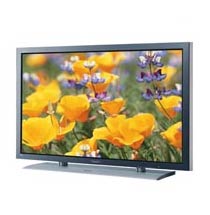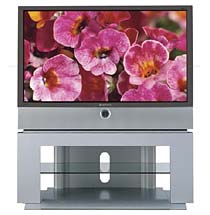 |


TechnoFILE is copyright and a registered trademark © ® of
Pandemonium Productions.
All rights reserved.
E-mail us Here!

TV, or Not TV?by Jim Bray The TV we've known and loved all our lives is dead. Well, okay, that's a tad overstated. But “old fashioned” TV, those cathod ray tube behemoths that have been the mainstay since TV's earliest days, are on their way out. Not tomorrow, but soon enough. Hence the new, flat screens that are taking up display space in the stores you visit. As CRT's die off, these new technologies will come on even stronger – while, farther down the road, even newer technological tricks are up the engineers' sleeves that promise to make today's LCD's and plasmas look as quaint as a VCR does today. But don't count the venerable CRT out just yet. According to Barry Murray, Director of the A/V group, Panasonic Canada, the old fashioned picture tube will be around for a while. “It's importance is shrinking,” he says, “But I don't expect it to be phased out completely before the end of the decade.” Murray expects two major transitions involving the CRT. First, the large screen, higher priced units will disappear over the next couple of years, but “Screen sizes smaller than 32 inches will remain significant” through this decade. The second transition is already under way: the change from 4:3 to 16:9 aspect ratios. Seeing how far LCD and plasma TV's have come in only a few years, it's easy to see why they're replacing CRT's. LCD's used to be suitable only for wrist watches, yet now you can get spectacular widescreen, HD-ready units. And it can be argued that plasma is advancing even more quickly. So which is best? “That's impossible to answer” says Murray. He says there's a still strong argument for CRT today, especially from a “bang for the buck” perspective, but that will change more quickly going forward. Murray predicts only “Baby step improvements in the CRT, while the other technologies have giant leaps coming.” In high end RPTV's (rear projection televisions), Murray says the technologies of LCD and DLP have matured to the point that the quality differences between them and a comparable CRT are mostly “In the eye of the beholder.” 
Then there's the issue of burn in, where the black or grey bars beside the 4:3 picture on a 16:9 TV can burn in over time. This has traditionally been a bugaboo of CRT and plasmas, though Murray disagrees. “It's more of a pig in a poke” he says of the burn in problem today, pointing out that newer generations of plasma have technology built in to minimize such potential. And of course these technologies are only going to get better, though there may be some slips along the way. LCOS, liquid crystal on silicon, for example, has been touted as the next big thing, yet Murray says the technology hasn't yet lived up to its potential. “LCOS has been talked about for years,” he says, “But so far nobody's been able to make it work for mass consumption.” This could change, of course. Sony's introduction of a true 1920 x 1080i LCOS chip in its front projection LCD line may point the way toward a bright and sharp future for affordable HDTV. However time will tell. Farther down the road are technologies such as OLED, which stands for “Organic Light Emitting Diode.” This may sound like a politically correct, environmentally friendly TV technology (and who knows, maybe it is), but if the geniuses in the labs can get around current problems such as a short life span and small screen size it could lead to wallpaper-thin televisions you can roll up and take with you to wherever the Superbowl party is being held. So which TV is best for you? Naturally, it depends. According to Les Enser of Matrix Video Communications, a Calgary-headquartered company that deals in everything from home theatre to broadcast and professional equipment, the LCD or DLP rear projector is a good bet for customers who want the big size of a CRT RPTV without losing half the room to it. “LCD's don't quite have the CRT's picture quality yet because of their black level performance,” Enser says, “But they're thinner and lighter and when you replace the bulb they're back to original spec.” DLP has better black level performance than LCD, though Enser says some people notice a strobing effect due to the spinning colour wheel. “This is being addressed, though,” he says. As for plasma and direct view LCD, the best of either persuasion are still expensive, with lower end ones cutting back on the quality to save costs. But “They sure look great on a wall,” says Enser. The bottom line for which TV will be best for a particular person, then, depends on your lifestyle, budget, and size of room. As usual. In this case, however, some of you may not only be looking for a great TV but, especially in the case of the ultra slim LCD and plasma sets, a bold fashion statement as well! And that's fine!
|
|
|
| Support TechnoFile via Paypal |
| TechnoFILE's
E-letter We're pleased to offer our FREE private, subscription-based private E-mail service. It's the "no brainer" way to keep informed. Our Privacy Policy |